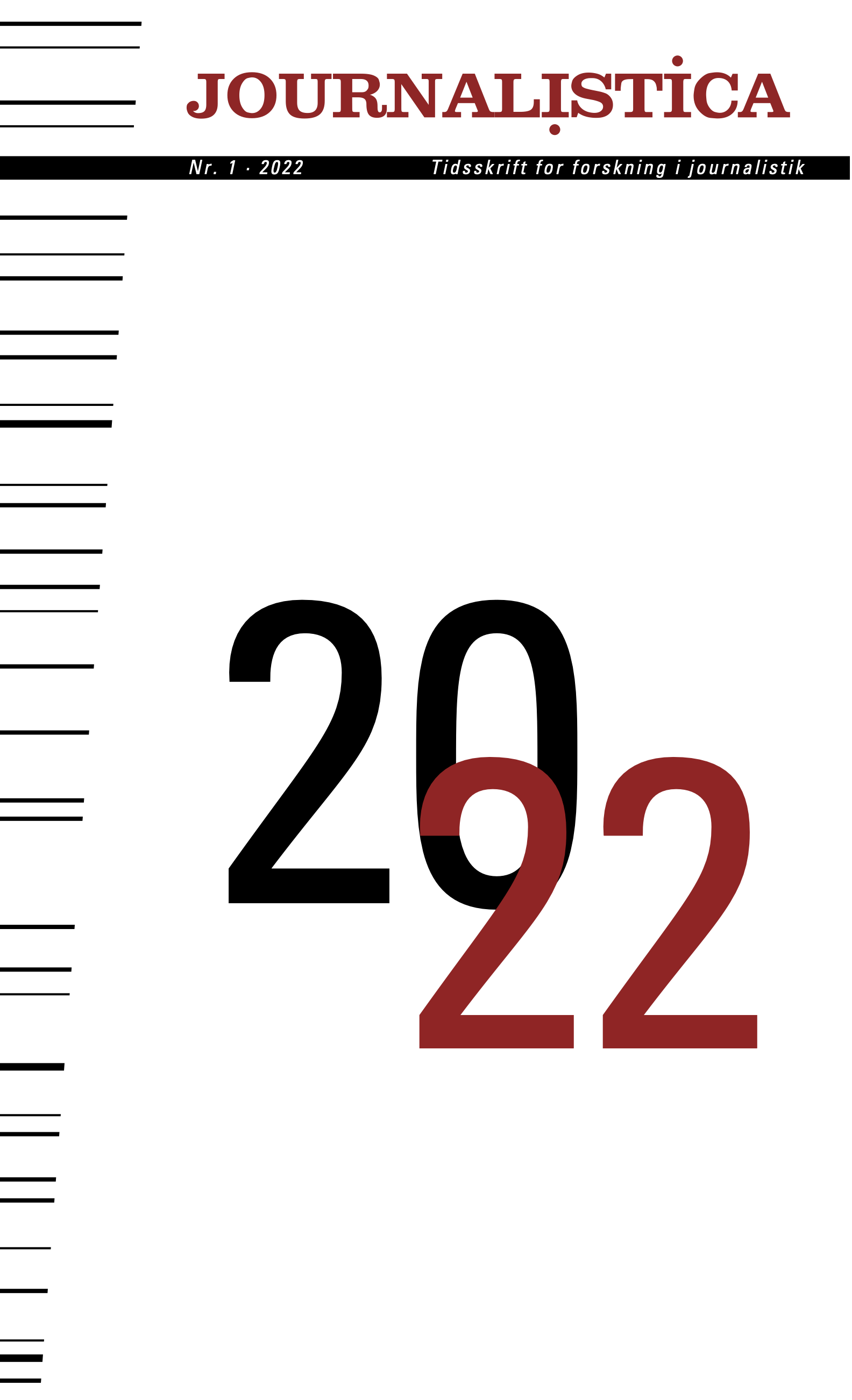Exploring the boundaries of Nordic journalism: Introduction to special issue
DOI:
https://doi.org/10.7146/journalistica.v16i1.135042Abstract
Keeping journalism socially relevant and financially viable is more challenging than ever. It might seem like a paradox, but in a time when news media is challenged by inadequate business models, precarious labor conditions and competition from platform companies, and contested by populist politicians, the public is consuming more news than ever before. The changing media landscape, technological platforms and structural conditions are influencing journalism, its practices and its roles in everyday life, society, culture, and politics—central topics when communication scholars gather at international and national conferences dedicated to media and communication research.
The NordMedia Conference 2021 was arranged in the midst of an ongoing pandemic. It was supposed to be held in Reykjavik, Iceland, but was ultimately held virtually. Naturally, the topics tended to focus on how journalists were covering the pandemic, but they also included studies on truth, disinformation and facts as well as technology in journalism in the form of AI and automation. The presenters were later invited to participate in this special issue, which celebrates Nordic scholarship and the Journalistica journal.
In this issue, we bring together three studies that each illustrate the current developments within Nordic journalism research along with a book review of a book on political communication in the Nordics.
Ethics and trust are common threads that run through the three articles published in this special issue of Journalistica. The articles cover very different topics—from podcasting as a genre, alternative media and comment moderation to ethics in local news media — and ethics and trust are recurring themes in the discussions. What constitutes as news today is increasingly blurred as it mixes with commercial content (influencers and content marketing — commercial genres that look like news), opinions (comments appearing as news) or false and manipulated content (fake news or disinformation). Many people, especially young adults, get their news from social media, and the newsfeed does not differentiate between different types of content. News from respected newsrooms has the same design as rumors from a suspicious website. Thus, users have to pay more attention to differentiate between the trustworthiness of the information.
This blurring of content and genres is challenging for journalism’s trustworthiness. The articles in this special issue touch on some of the challenges appearing as a result of this blurring despite the long tradition of strong ethical guidelines for journalism in Nordic newsrooms. Nevertheless, the users of Nordic news are still demonstrating high levels of trust, among the highest in the 45 countries of the Reuters Digital News Report 2022 track. Finnish news users report the highest trust in news (69%), particularly the news they use (75%), followed by Denmark (58%/63%), Norway (56%/63%), and Sweden (50%/56%). Iceland was not included in Reuters’ survey.
One factor that can help maintain and strengthen trust in news in the Nordic countries is strong ethical practices in newsrooms. Since the early 20th century, Nordic newsrooms and journalism organizations have developed ethical guidelines for journalism that are continually updated to reflect developments in the profession and society at large:
- Norway:Code of Ethics for the Norwegian Press
- Sweden: Rules of Professional Conduct
- Denmark: Press Ethical Rules
- Finland: Guidelines for Journalists
- Iceland: Rules of Ethics in Journalism
Ethical guidelines and their practical implementation in the newsrooms can help Nordic journalists navigate the challenges emerging from the changing media landscape, competition from technological platforms and structural conditions influencing journalism. The articles in this special issue of Journalistica each offer a unique contribution to address some of these challenges.
References
Anderson, A. A., Yeo, S. K., Brossard, D., Scheufele, D. A., & Xenos, M. A. (2016). Toxic talk: How online incivility can undermine perceptions of media. International Journal of Public Opinion Research, 30(1), 156–168. https://doi.org/10.1093/ijpor/edw022
Haanshuus, B. P. (2022). Freedom of expression or censorship of antisemitic hate speech? Editorial and audience perspectives on comment moderation in far-right alternative media. Journalistica, 16(1). https://doi.org/10.7146/journalistica.v16i1.130043
Hujanen, J., Grönlund, M., Ruotsalainen, J., Lehtisaari, K., & Vaarala, V. (2022). The ethics of journalism challenged: the blurring boundary between local journalism and communications. Journalistica, 16(1). https://doi.org/10.7146/journalistica.v16i1.128894
Ihlebæk, K. A., Løvlie, A. S., & Mainsah, H. (2013). Mer åpenhet, mer kontroll? Håndteringen av nettdebatten etter 22. juli. Norsk Medietidsskrift, 20(03), 223–240. https://doi.org/10.18261/ISSN0805-9535-2013-03-03
Jensen, J. L. (2022). Book review: Eli Skogerbø, Øyvind Ihlen, Nete Nørgaard Kristensen og Lars Nord (red.): Power, Communication and Politics in the Nordic Countries. Nordicom, 2021, 396 pp. Journalistica, 16(1). https://doi.org/10.7146/journalistica.v16i1.133972
Morini, F., Dörk, M., & Appelgren, E. (2022). Sensing what’s new: considering ethics when using sensor data in journalistic practices. Digital Journalism, 1-19. https://doi.org/10.1080/21670811.2022.2134161
Morlandstø, L. & Mathiesen, B. R. (2022). Podcasts – Commentary journalism in a digital public. Journalistica, 16(1).
Usher, B. (2020). The celebrified columnist and opinion spectacle: Journlism’s changing place in networked public spheres. Journalism 22(11), 2836-2854. https://doi.org/10.1177/1464884919897815
Downloads
Published
How to Cite
Issue
Section
License
Copyright (c) 2022 Ester Appelgren, Bente Kalsnes

This work is licensed under a Creative Commons Attribution 4.0 International License.
Forfattere, der publicerer deres værker via dette tidsskrift, accepterer følgende vilkår:
- Forfattere bevarer deres ophavsret og giver tidsskriftet ret til første publicering, samtidigt med at værket er omfattet af en Creative Commons Attribution-licens, der giver andre ret til at dele værket med en anerkendelse af værkets forfatter og første publicering i nærværende tidsskrift.
- Forfattere kan indgå flere separate kontraktlige aftaler om ikke-eksklusiv distribution af tidsskriftets publicerede version af værket (f.eks. sende det til et institutionslager eller udgive det i en bog), med en anerkendelse af værkets første publicering i nærværende tidsskrift.
- Forfattere har ret til og opfordres til at publicere deres værker online (f.eks. i institutionslagre eller på deres websted) forud for og under manuskriptprocessen, da dette kan føre til produktive udvekslinger, samt tidligere og større citater fra publicerede værker (se The Effect of Open Access).




